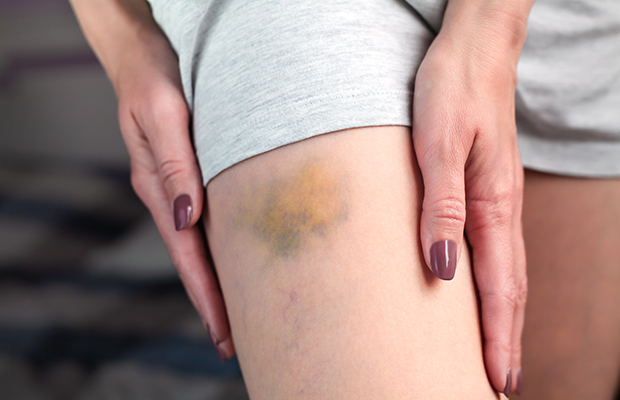Bruises are a common occurrence, often resulting from injuries or trauma to the body. They can vary in color, starting off as blue, purple, or black, and eventually turning yellow or green. The change in color signifies the different stages of the healing process.
When a bruise is fresh, it appears as a dark blue or purple mark on the skin. This initial color is a result of the blood vessels beneath the skin breaking and leaking blood. As time goes on, the body starts to break down the red blood cells, releasing hemoglobin into the surrounding tissues.
Hemoglobin, a protein that contains iron, is responsible for carrying oxygen in the blood. When it is released from the damaged blood vessels, it undergoes a series of chemical changes. As a result, compounds called biliverdin and bilirubin are produced.
Biliverdin is a green pigment, while bilirubin is yellow. These compounds give the bruise its characteristic yellow or green color as they accumulate in the damaged tissues. This change in color is a positive sign, indicating that the body is effectively breaking down and metabolizing the hemoglobin.
As time progresses, the body continues to clear away the broken-down blood cells and metabolize the biliverdin and bilirubin. This process typically takes around 5 to 10 days, depending on the severity of the bruise. Eventually, the bruise fades away completely, leaving behind no visible mark.
It is important to note that the healing time for bruises can vary from person to person. Factors such as age, overall health, and the location of the bruise can all influence the healing process. While most bruises follow a similar progression of color changes, it is always advisable to consult a healthcare professional if you have any concerns about your bruise.
A yellow bruise indicates the final stage of healing. The yellow color comes from the breakdown of hemoglobin and the production of biliverdin and bilirubin. Understanding the different stages of bruise healing can help individuals track their progress and ensure proper care.
What Does It Mean If A Bruise Is Turning Yellow?
When a bruise turns yellow, it indicates that the healing process is nearing completion. This yellow color is a characteristic feature of the final stage of healing for a bruise. During the healing process, red blood cells break down, and as a result, hemoglobin, a protein containing iron, is released into the body. The breakdown of hemoglobin leads to the formation of bilirubin, which gives the bruise its yellowish hue. This change in color suggests that the body is reabsorbing the remaining byproducts of the bruise, indicating that the injury is healing and will soon be completely resolved.

Is It Normal For A Bruise To Look Yellow?
It is normal for a bruise to look yellow. As mentioned earlier, when a bruise is a few days old, it typically appears blue, purple, or black. However, as the body starts to break down the hemoglobin in the bruised area, it produces compounds called biliverdin and bilirubin. These compounds give the bruise its yellow or green color.
The change in color from blue or purple to yellow or green usually occurs around 5-10 days after the bruise first appears. This change in color is a natural part of the healing process as the body reabsorbs the blood that has pooled under the skin.
It is perfectly normal for a bruise to look yellow as it progresses through the healing stages. The yellow color is a result of the breakdown of hemoglobin and the production of biliverdin and bilirubin.
Conclusion
The healing process of a bruise involves a series of color changes that indicate the progress of recovery. Initially, a bruise appears blue, purple, or black, which indicates the presence of broken blood vessels beneath the skin. Over time, the body breaks down the accumulated red blood cells, releasing hemoglobin. As the hemoglobin is broken down further, it produces compounds called biliverdin and bilirubin, giving the bruise a yellow or green color. The yellow hue signifies that the bruise is in its final stages of healing and will soon be completely healed. This natural process demonstrates the body’s ability to repair itself and restore damaged tissues.
